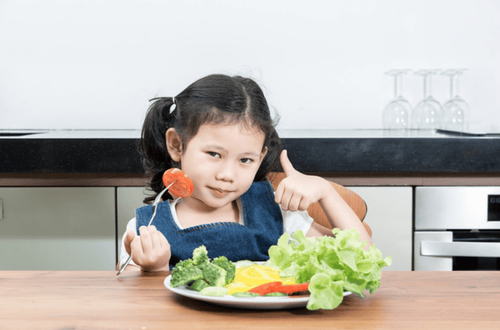This is an automatically translated article.
Initiating hand-feeding can be fun, but it can also be a puzzling experience for many parents when starting to feed their baby.
1. What is baby food to pick up?
Any bite-sized, easy-to-eat food that your baby can pick up, hold, and eat on his own qualifies as baby food. Many people may not know, in fact, picking food by hand during weaning is a joy for babies. It's also an important step in your baby's development, helping them move toward independence as well as develop their motor skills and coordination.
2. When should children self-feed when weaning?
When babies reach 8 to 9 months old, babies will show signs to show mothers that they are ready to scoop or pick up food by grabbing the spoon that mothers are using to help themselves. shovel food into the mouth. There are also some parents who let their children pick up food with their fingers when the baby is 6 months old. They skip the spoon feeding stage and let the baby hold or pick up soft foods to put in their mouths.
At first, your baby can just pick up a handful of food in his hand and bring it to his mouth, but gradually he will learn to use his thumb and index finger flexibly to pick up food. This motor skill of the child is called pincer grasp.
3. How to guide children to hold food?
The simplest method that mothers can use is to place finger-cut pieces of food on the child's tray. Additional pieces of food can then be placed while the child is eating. Mothers should also pay attention to fix the child in a position such as a dining chair, should choose high chairs, with bars so that the baby does not slip out of the chair. Children should not be placed in strollers or car seats, motorbikes, ... because this increases the risk of choking for children and makes them unable to focus on their own eating.
4. Which weaning foods should be chosen so that children can pick up?
Because at this time, the baby's teeth are not fully developed, so mothers can choose soft foods that are easy to chew with the baby's gums or foods that dissolve easily in the mouth. Over time, as children grow older, mothers can change, choose larger, more suitable pieces of food. In addition, mothers should try to prepare more foods for their children so that children can feel the color and taste of each food as well as fully supplement vitamins and minerals for children. . Children often love sweets like cookies, cakes or high-fat snacks like cheesecake, fast foods like chips. However, mothers must avoid their temptation because at this time, babies need foods rich in nutrients and easy to digest, not foods that are low in calories.
Cha mẹ nên hướng dẫn trẻ cách cầm thức ăn khi ăn bốc
Parents also need to remember to choose foods that are appropriate for the child's age. Experts once advised not to give young children eggs, fish or peanut products because these are foods that are easy to cause allergies for young children. But according to the latest studies from the American Academy of Pediatrics, there is no evidence that babies have allergies from the moment they eat these foods. However, butter, especially peanut butter, is still recommended to limit use for babies because they are too sticky and can make it difficult for children to swallow or even block their airways.
Some experts also recommend that parents be cautious when introducing new foods to babies. If you're worried your baby might be allergic to certain foods, try them in gradually increasing amounts and closely monitor your baby's reaction after eating.
Here's a list of some foods that soliders can scoop or feed themselves:
O-shaped toasted oat cereal or other low-sugar cereals Shredded toast with ingredients vegetables to give your baby vitamins Small pieces of banana or other ripe fruit such as mango, plum, pear, peach, cantaloupe or seedless watermelon. Be sure to cut small pieces just enough for the baby to avoid the risk of choking, leading to airway obstruction. Small pieces of tofu Shredded pasta well cooked and cut into bite-sized pieces Cheeses cut into soft and small pieces Boiled eggs finely chopped casseroles and minced meat pieces cooked and chopped such as carrots, peas, zucchini, potatoes or sweet potatoes. Well-cooked cauliflower pieces of cooked chicken, ground beef or turkey or other tender meats cut into pea-sized pieces.

Bông súp lơ nấu chín kỹ có thể dùng cho trẻ ăn bốc
5. Keeping babies safe when weaning with hands
Mothers need to make sure that babies sit upright to eat and do not lie on their sides or stomach while eating. Always make sure the child eats in a sitting position, make sure he does not run and bring food to his mouth.
Parents and caregivers need to make sure no one but the baby puts food in their mouths, especially for families with many young children and their siblings who may be trying to feed them. for my brother. Never leave children alone with food, they should always be supervised until they have finished eating
Do not let children eat foods that are cut too large or pose a risk of choking.
6. Newborns vomit and choke when eating
One of the things that worries parents the most when they start hand-feeding their babies is choking. Often, anxiety about choking comes from watching a child swallow food. Although choking and vomiting are related, they are not essentially the same thing. It's completely normal for babies to vomit food. This is the body's natural response that is triggered when food touches a sensitive area on the tongue or roof of the mouth. When a child vomits, unswallowed food is pushed forward in a gobbling motion. Although it can be difficult to worry, babies generally don't have too much of a problem if they vomit food out.
Choking occurs when the airways are partially or completely blocked. When something blocks the baby's airway, the body's natural reflex will be to cough to try to push the object out. In cases where the airway is completely blocked and the child is really choking, the child will become silent and gradually pass out because air cannot circulate. This is also the reason why children should never be left alone with food, especially those who are picky eaters.
7. Foods that should be avoided or taken care of when feeding children
Some foods are not recommended to be given to children or need to be very careful when feeding them:
Whole nuts or large nuts should be avoided because they can get stuck in the baby's windpipe Popcorn and Whole grains: Should be avoided because they can cause airway obstruction in children. Honey: Absolutely avoid giving honey to children under 12 months of age. Honey may contain spores of the bacteria Clostridium botulinum which can lead to infant botulism. Whole fruits have seeds. All seeds should be removed before feeding. Fish: Carefully remove all fish bones before feeding to children. Also need to avoid some types of fish that are not good for health, with high mercury content such as swordfish and mackerel Meat: Pay attention to remove bones and small hairs. Processed foods should be avoided because they contain too much sodium for infants. Salt: Children should not eat more than 1g of salt, equivalent to 0.4g of sodium per day. Sodium also exists in other foods that children eat so there is no need to add salt to their diet. Sugar: Sugars provide empty energy without nutrients, and they can also spoil baby's teeth, so it should be avoided if possible. Sticky foods: Sticky foods such as candy, jelly can get stuck in the child's throat. Hard foods: Avoid hard foods like raw carrots and apples because there is a risk that food particles can break and block the baby's airway. It is recommended to cook these foods to soften them.

Khi chế biến đồ ăn dặm cho trẻ, cha mẹ cần lưu ý một số loại thực phẩm cần tránh dùng
There are many snacks for the baby to eat during the weaning process. However, the advice of experts is not to buy these foods for children to eat because mothers can completely prepare delicious and nutritious weaning dishes for their children at home. Give your child a variety of fruits or vegetables to supplement vitamins. The main fruit is also the perfect dish for mothers to bring when taking their children out as well as easy to store.
For children to be healthy and develop well, it is necessary to have a nutritious diet in terms of quantity and quality balance. If children are not provided with adequate and balanced nutrients, it will lead to diseases of excess or lack of nutrients, which adversely affect the comprehensive development of children in terms of physical, mental and motor skills.
The period of baby eating solid foods is an extremely important period to help children develop comprehensively. Children who do not eat properly are at risk of micro-mineral deficiencies, causing anorexia, growth retardation, malabsorption, etc. If they notice the above signs, parents should supplement their children with supportive products. The supplement contains lysine, essential micro-minerals and vitamins such as zinc, chromium, selenium, and B vitamins to help fully meet the nutritional needs of children. At the same time, these essential vitamins also support digestion, enhance nutrient absorption, help improve anorexia, and help children eat well.
Parents can learn more:
Signs of zinc deficiency in children
Micronutrient deficiency and failure to gain weight in children
Please regularly visit Vinmec.com website and update useful information to take care of your child. Take care of the baby and the whole family.
Reference sources: babycenter.com, healthylittlefoodies.com













